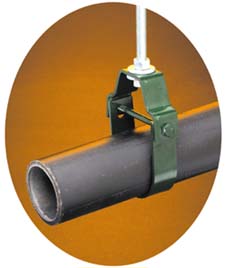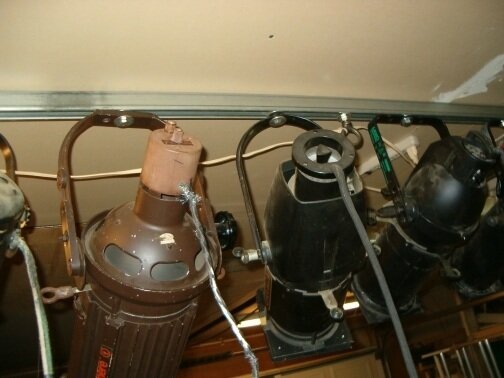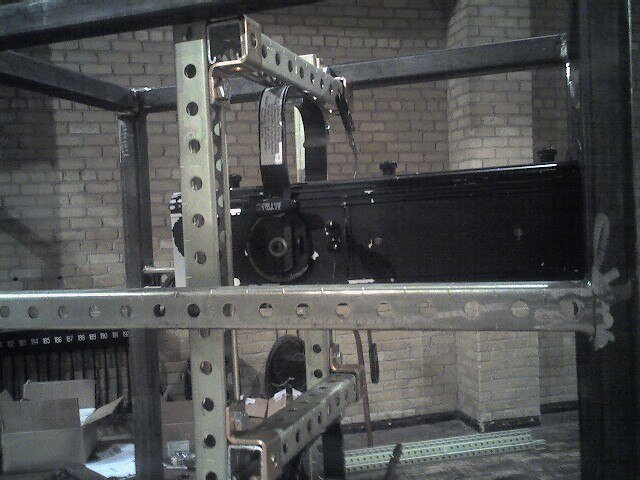There are several different threads going on here all at once. I'll try to touch on them separately as it gets somewhat confusing and intertwined otherwise. Also, just a small
point on semantics, when you say 40
gauge, I gather you mean Schedule 40 pipe.
The threads as I see them are:
1. Attaching a pipe to a ceiling.
2. Who can properly calculate the project.
3. Who can properly install the product.
4. Strut: Properties and types of accessories.
First, how to attach a pipe. The
Clevis hanger posted earlier is all too often used for this but it is not rated for this purpose. It is designed to hold the weight of the pipe and it's contents in a static situation. A lighting pipe must be rigged to hold it's own weight plus at least 25# per
foot of equipment, in a
dynamic loading situation.
Dynamic you say??? It's not moving, just hanging there! Every time a
stagehand hangs or strikes a
unit there is a changing load on the hanger, this does not take into account the forces imposed if a mover is hung on the pipe. The
clevis hanger is relatively weak where the threaded rod goes through it. A rated
pipe clamp,
Pipe Clamps - Half Pipe & Full Pipe designed to hold rigged pipe with scenery or lights over peoples heads plus a rated bracket
Automatic Devices Company designed to support the pipe and load from threaded rod should be used. The
clevis bracket will allow the pipe to rotate or spin if units are side hung. A
pipe clamp from a theatrical rigging company is designed to prevent this.
2. Who can calculate the project, strength of structure, necessary fastener strength,
etc.? This requires a Structural Engineer. Many Competent Riggers can evaluate a situation and determine if an engineer is needed or not. If the Rigger is indeed Competent, they will advise an engineer be contacted about 80% of the time. There are situations where a Competent Rigger can make this decision, and in those situations he and/or his company (and their insurance
carrier) become the responsible and liable parties for any work done under that contract.
3. Who can install the project. Any company who specializes in rigging installations and some General Contracting companies. Most General contractors will consult with a rigging company or subcontract to them, as rigging is what is known in the business as a "Specialty" trade. General contractors need very specific guidance when installing theatrical/entertainment industry rigging. It is little things like making sure there is clearance for the
C clamp to fit on the pipe. On a recent job the contractor actually attached a
conduit run to the pipe and had to remove it when we demonstrated the way a
stage lighting
instrument had to attach to the pipe.
Stage rigging companies including the one I am employed by, install structural steel as well as winches , hoists,
counterweight rigging and
dead hung pipes and pipe grids. However, when we install structural components, we do so only with the stamped approval of a licensed structural engineer, specifying and approving the type and size of the structural members, the method of attachment and specific fasteners. On jobs out of state we have to make sure the engineers license is recognized in the state of the installation. Installing pipes in situations such as the original poster asked about are exactly what Certified Riggers do. When we install pipe grids, they are most often hung from rod, cable or chain that is attached to eyes, rods or brackets installed into concrete ceilings, precast beams or similar. Are we (Me) competent to calculate the loading and the fastener strength and type??? Absolutely Not! I can usually predict the type and size of fastener, but I will not spec them and guarantee the results. An educated guess, no mater how experienced is not a performance guarantee. If the owner/GC does not have a structural working on the project, we hire one. Once he calculates the load capability of the substrate (concrete, brick,
etc.) in the direction we will be applying the load, he will often ask us for a fastener suggestion. This is because there are hundreds of fasteners and anchors for these applications, some are awkward to use for our applications, some are not cost effective for installation or expected life. Our experience as riggers has introduced us to a range of fasteners that are very suitable for the application. With our suggestion, he only has to do calculations on a small number of of fasteners to find the most suitable for the situation.
4. Strut. Strut is a universal product. There are many different brands. In addition to the ones mentioned, there are Uni-Strut (the father of all strut) B-Line, Cooper, G Strut,
Power Strut, et.al. All strut of the same size, fits the same nuts, brackets
etc for any brand. The various manufacturers go to a great deal of trouble to make sure they are interchangeable with the other brands. Otherwise no one would use theirs. I will often use strut from one brand and fittings from one or two others, depending on "off the shelf" availability at the time. The issue is that there many different sizes of strut
channel. The most common is 1-5/8"x1-5/8"
Unistrut Component Detail it comes in many variations but all are 1-5/8" across the open side. Other common sizes are 1-1/4"
Unistrut Component Detail and 13/16"
Unistrut Component Detail . All of the
channel sizes come in many different configurations, back to back, double deep, side to side, side to back et.al.
Unistrut Product Group .
For Lighting use, (I agree IMHO with the people who say it is inconvenient) However, there are many accessories to
ease the pain such as the
City Theatrical line. I have personally used their
Track Tamer and like it a lot, but it is not cheap
City Theatrical click on lighting accessories on the left
hand menu, then click
track tamers, to see
Track Tamers. Also, someone mentioned putting a rod in the spring
nut, to
ease hanging, this is problematic and could be a potential danger as any slight twist of the
instrument during focus can leave the rod loose and risk coming undone. However, there is a stud
nut that does the same thing
Unistrut Component Detail . Someone mentioned that the
yoke did not move/pivot easy when almost in
line with the strut. When hanging lights from strut (unless using a
Track Tamer) there should be a square
flat strut washer between the
yoke and the strut
channel.
Unistrut Component Detail . I prefer a variation called a non rotating washer
Unistrut Component Detail that is crimped on two sides to fit the strut slot and prevent rotation. This allows the use of a lock washer in rigging applications, creating a rated rigging attachment.
Hope this helps to
clear a few things up.





